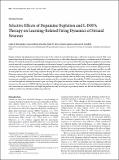| dc.contributor.author | Hernandez, Ledia F. | |
| dc.contributor.author | Kubota, Yasuo | |
| dc.contributor.author | Hu, Dan | |
| dc.contributor.author | Howe, Mark William | |
| dc.contributor.author | Lemaire, Nune | |
| dc.contributor.author | Graybiel, Ann M. | |
| dc.date.accessioned | 2013-10-04T17:10:35Z | |
| dc.date.available | 2013-10-04T17:10:35Z | |
| dc.date.issued | 2013-03 | |
| dc.date.submitted | 2013-01 | |
| dc.identifier.issn | 0270-6474 | |
| dc.identifier.issn | 1529-2401 | |
| dc.identifier.uri | http://hdl.handle.net/1721.1/81325 | |
| dc.description.abstract | Despite evidence that dopamine neurotransmission in the striatum is critical for learning as well as for movement control, little is yet known about how the learning-related dynamics of striatal activity are affected by dopamine depletion, a condition faced in Parkinson's disease. We made localized intrastriatal 6-hydroxydopamine lesions in rats and recorded within the dopamine-depleted sensorimotor striatal zone and its contralateral correspondent as the animals learned a conditional maze task. Rather than producing global, nonspecific elevations in firing rate across the task, the dopamine depletion altered striatal projection neuron activity and fast-spiking interneuron activity selectively, with sharply task-specific and cell type-specific effects, and often, with learning-stage selective effects as well. Striatal projection neurons with strong responses during the maze runs had especially elevated responsiveness during the maze runs. Projection neurons that, instead, fired most strongly before maze running showed elevated pre-start firing rates, but not during maze running, as learning progressed. The intrastriatal dopamine depletion severely affected the learning-related patterning of fast-spiking interneuron ensembles, especially during maze running and after extended training. Remarkably, L-DOPA treatment almost entirely reversed the depletion-induced elevations in pre-run firing of the projection neurons, and elevated their responses around start and end of maze runs. By contrast, L-DOPA failed to normalize fast-spiking interneuron activity. Thus the effects of striatal dopamine depletion and restoration on striatal activity are highly dependent not only on cell type, as previously shown, but also on the behavioral activity called for and the state of behavioral learning achieved. | en_US |
| dc.description.sponsorship | National Parkinson Foundation (U.S.) | en_US |
| dc.description.sponsorship | National Institutes of Health (U.S.) (National Institute of Neurological Disorders and Stroke (U.S.) P50 NS-38372) | en_US |
| dc.description.sponsorship | Stanley H. and Sheila G. Sydney Fund | en_US |
| dc.description.sponsorship | Parkinson's Disease Foundation (U.S.) (Fellowship) | en_US |
| dc.description.sponsorship | Fulbright Program (Fellowship) | en_US |
| dc.language.iso | en_US | |
| dc.publisher | Frontiers Research Foundation | en_US |
| dc.relation.isversionof | http://dx.doi.org/10.1523/jneurosci.3746-12.2013 | en_US |
| dc.rights | Article is made available in accordance with the publisher's policy and may be subject to US copyright law. Please refer to the publisher's site for terms of use. | en_US |
| dc.source | Society for Neuroscience | en_US |
| dc.title | Selective Effects of Dopamine Depletion and L-DOPA Therapy on Learning-Related Firing Dynamics of Striatal Neurons | en_US |
| dc.type | Article | en_US |
| dc.identifier.citation | Hernandez, L. F., Y. Kubota, D. Hu, M. W. Howe, N. Lemaire, and A. M. Graybiel. “Selective Effects of Dopamine Depletion and L-DOPA Therapy on Learning-Related Firing Dynamics of Striatal Neurons.” Journal of Neuroscience 33, no. 11 (March 13, 2013): 4782-4795. | en_US |
| dc.contributor.department | Massachusetts Institute of Technology. Department of Brain and Cognitive Sciences | en_US |
| dc.contributor.department | McGovern Institute for Brain Research at MIT | en_US |
| dc.contributor.mitauthor | Hernandez, Ledia F. | en_US |
| dc.contributor.mitauthor | Kubota, Yasuo | en_US |
| dc.contributor.mitauthor | Hu, Dan | en_US |
| dc.contributor.mitauthor | Howe, Mark William | en_US |
| dc.contributor.mitauthor | Lemaire, Nune | en_US |
| dc.contributor.mitauthor | Graybiel, Ann M. | en_US |
| dc.relation.journal | Journal of Neuroscience | en_US |
| dc.eprint.version | Final published version | en_US |
| dc.type.uri | http://purl.org/eprint/type/JournalArticle | en_US |
| eprint.status | http://purl.org/eprint/status/PeerReviewed | en_US |
| dspace.orderedauthors | Hernandez, L. F.; Kubota, Y.; Hu, D.; Howe, M. W.; Lemaire, N.; Graybiel, A. M. | en_US |
| dc.identifier.orcid | https://orcid.org/0000-0001-9197-7711 | |
| dc.identifier.orcid | https://orcid.org/0000-0003-2381-0834 | |
| dc.identifier.orcid | https://orcid.org/0000-0002-4326-7720 | |
| mit.license | PUBLISHER_POLICY | en_US |
| mit.metadata.status | Complete | |
